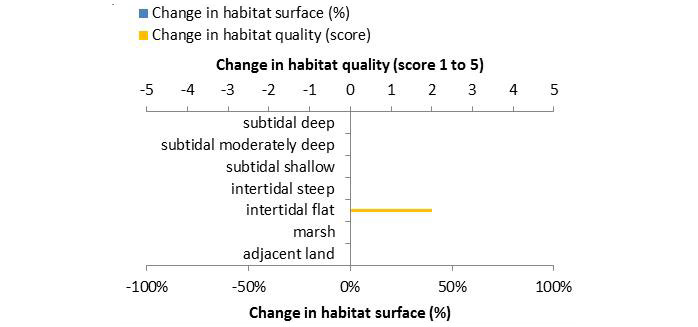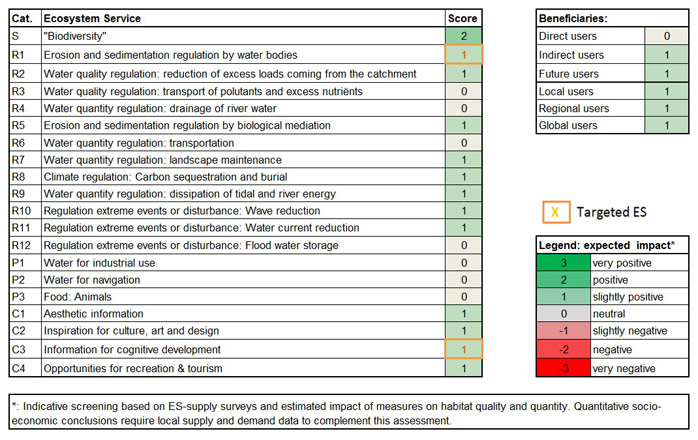

Disclaimer:
The authors are solely responsible for the content of this report. Material included herein does not represent the opinion of the European Community, and the European Community is not responsible for any use that might be made of it.
Back to overview measures
The measure Groynes at Waarde in the mesohaline zone of the Scheldt estuary was about the protection of intertidal flat habitat against erosion, improving the habitat quality.
Before the measure the intertidal flat habitat was in bad condition because of erosion. Additionally erosion had already led to the underlying peat layer. This layer was very poor in benthos species and the fear was that the erosion would continue over the entire flat habitat letting the peat layer outcrop and a general decrease in soil quality.
After the construction of the groynes the quality of the intertidal flat habitat increased because of reduced erosion and more important enhanced sedimentation with a positive effect on benthos species and the overall soil quality.
Step 2: Expected impact on ecosystem services, compared with targeted ecosystem services, and expected impact on beneficiaries
More information about the methodology and the correct interpretation of the results could be found in the overall measures report (Saathoff et al. 2013).
(1) Overall expected impact on ES: From the ES assessment it is concluded that this measure generates overall a slightly positive expected impact for many ES, with a positive expected impact on “Biodiversity”.
(2) Expected impact on targeted ES: The first target (erosion prevention) corresponds with the ES ‘Erosion and sedimentation regulation by water bodies’ and the second target (preserve an old village) corresponds with the ES ‘Information for cognitive development’. The expected impact on both targets is slightly positive.
(3) Expected impact on beneficiaries: The expected impact for the different beneficiary groups is overall slightly positive.
Back to top
Groynes at the marsh near Waarde
Table of content
- 1. Description of measure
- 1a. Measure description
- 1b. Monitoring
- 1c. Monitoring results
- 2. Execution of main effectiveness criteria
- 2a. Effectiveness according to development targets of measure
- 2b. Impact on ecosystem services
- 2c. Degree of synergistic effects and conflicts according to uses
- 3. Additional evaluation criteria in view of EU environmental law
- 3a. Degree of synergistic effects and conflicts according to WFD aims
- 3b. Degree of synergistic effects and conflicts according to Natura 2000 aims
- 4. Crux of the matter
- 5. References
Additional information
for this measure:
No further information available.
for this measure:
No further information available.
Impact on ecosystem services
Step 1: Involved habitatsThe measure Groynes at Waarde in the mesohaline zone of the Scheldt estuary was about the protection of intertidal flat habitat against erosion, improving the habitat quality.
Before the measure the intertidal flat habitat was in bad condition because of erosion. Additionally erosion had already led to the underlying peat layer. This layer was very poor in benthos species and the fear was that the erosion would continue over the entire flat habitat letting the peat layer outcrop and a general decrease in soil quality.
After the construction of the groynes the quality of the intertidal flat habitat increased because of reduced erosion and more important enhanced sedimentation with a positive effect on benthos species and the overall soil quality.
Step 2: Expected impact on ecosystem services, compared with targeted ecosystem services, and expected impact on beneficiaries
More information about the methodology and the correct interpretation of the results could be found in the overall measures report (Saathoff et al. 2013).
(1) Overall expected impact on ES: From the ES assessment it is concluded that this measure generates overall a slightly positive expected impact for many ES, with a positive expected impact on “Biodiversity”.
(2) Expected impact on targeted ES: The first target (erosion prevention) corresponds with the ES ‘Erosion and sedimentation regulation by water bodies’ and the second target (preserve an old village) corresponds with the ES ‘Information for cognitive development’. The expected impact on both targets is slightly positive.
(3) Expected impact on beneficiaries: The expected impact for the different beneficiary groups is overall slightly positive.

